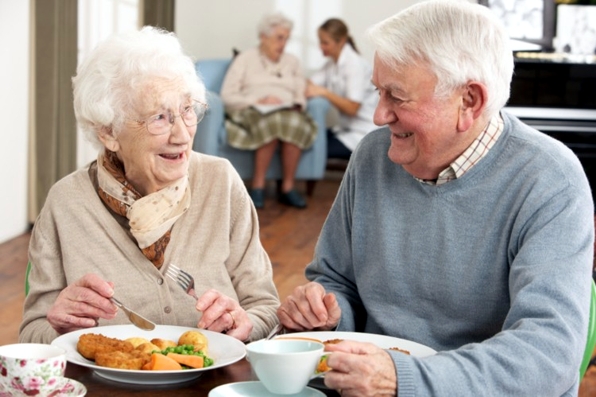There’s an epidemic scourging our elderly loved ones who are ‘aging in place’, or staying in their own homes rather than going into assisted living arrangements. ‘Food insecurity’ is a stealthy social villain that can sneak up on those unaware of or unable to protect themselves from poor eating habits…
 Seniors eat better, in particular, and ‘do’ better, in general, when living with others
Seniors eat better, in particular, and ‘do’ better, in general, when living with others
and receiving assistance with the provision and preparation of their food…
The American Council for Aging Care (ACAC) advocates ‘Aging In Place’, where seniors stay in their homes or are taken into the homes of their younger relatives when they begin to require assistance with life’s basic activities. One of the most important of those activities is maintaining a sufficient, varied and nutritious diet and good eating habits. That’s not hard if you’re in an assisted living situation or a nursing home, but seniors on their own, aging in place, are particularly prone to let their eating habits slide and rely more on ‘convenient’ foods as time goes by.
The ACAC reports that one in six American seniors currently faces either hunger or undernourishment, in spite of the fact that we live in the most plentiful and varied food system on earth:
This applies to those who aren’t sure where their next meal is coming from and those who don’t have access to the healthiest possible food options. The issue is severe enough that the AARP reports that seniors face a healthcare bill of more than $130 billion every year due to medical issues stemming from senior hunger.
Why is this happening?
There are some surprisingly simple answers to that question. Some seniors, whose retirement savings were hit hard by the recession of 1007-08, have had to cut back on food spending to ensure that can continue to pay other bills. Others aren’t able to get out and shop regularly for fresh and varied foods. Others just do what’s easiest at mealtime. They may rely on prepared or convenience foods. And they may rely on what’s cheap, rather than on what’s more nutritious.
What are the main factors driving Food In security?
In the U.S., three core factors influence the risk that seniors will become food insecure.
Income level is first, a factor that determines a senior household’s ability to afford proper food.
…Nearly 80 percent of seniors “below 50 percent of the poverty line,” which in 2013 was $15,510 for a two-person household, were at some level of food insecurity. [But] while food insecurity rates dropped closer to and above the poverty line, the report clarifies that “hunger cuts across the income spectrum.” More than 50 percent of seniors who are at-risk of being food insecure live above the poverty line.
Next comes Race, a factor that may have a greater impact in the U.S. than anywhere else.
While the AARP points out that, as you age, the rate of food insecurity raises among all races and ethnicities, there are still those who experience food insecurity at much higher rates.
“African-American households are two to two-and-a-half times as likely to be in one of the three [food insecurity] categories as the typical senior household,” the report clarified, also noting that Hispanics face similar odds. It’s also more likely in both these minority groups for someone to be food insecure if they are widowed or divorced and live alone.
Finally, Food Deserts account for a significant increase in the risk of seniors food insecure. Food Deserts often occur in inner cities where there are no supermarkets except at great distances from many homes. Seniors, especially, are at risk of losing access to decent food if they cannot travel the distance to a supermarket.
The decline of ‘family’…
I believe that the decline in the traditional family structure, and the alliances it fosters between young and old, is a major factor influencing the increasing nutrition issues among seniors.
When I was young, learning my values and priorities from my parents and other elders, family always made sure family had enough good food to eat, clothes on their backs and companionship. My memories of the seniors in my extended family when I was young are uniformly of folks who were integrated into ‘the family’, who were supported unquestioningly and who were happy.
My own parents, however, lived in a different, post-WW II world, where their kids didn’t stay in the same town to live and work and bring up their families, and where family support was thinner and more distant. My generation is completely on its own, food-, shelter- and comfort-wise. It’s a sobering realization. This societal trend will only contribute to the growing problem of food insecurity among all of us, though seniors will probably remain at greater risk.
~ Maggie J.

